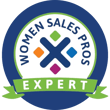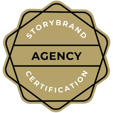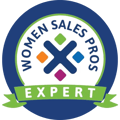3 Keys to Successful Selling for Non Sales People (Part 3)
by Shawn Karol Sandy, on May 8, 2016 2:49:00 PM
I realized we’ve struck a nerve with this series, Selling for Non-Sales People. When I mention we’ve rolled out an intensive coaching program, the response is to grab my arm and say “YES! I NEED THIS” with giant eyes and emphatic jerking on my arm.
The response in the first weeks has blown me away and we’ve booked strategic intensive days with bankers, attorneys, financial planners, fundraisers, and business owners.
If you’re ready to move yourself to the next level and make selling your priority, we’ve broken it down for you into 3 parts:
Successful Selling for Non-Sales People
Consistency is possibly more important than being persistent. It’s also where many of us struggle to successfully achieve our goals in almost everything.
Consistency is important in selling as it helps you achieve forward progress, measurable, and repeatable results. We recognize that this is incredibly difficult for business owners or key stakeholders that are pulled in 132 directions each and every day. That doesn't mean it's impossible, to create consistency though. It means you need a plan.
The last key to helping more people buy you is to
Part 3: Be Consistent by Building A Repeatable Process
You should have a written plan, a documented sales process, that you create to purposefully work your strategy to connect, compel, and convert customers. Think of this as your “sales playbook” where your sales strategy is executed through actions in your sales process. Your sales playbook should include the following:
- Clearly defined target customers and where to find them
- Prequalifying criteria to move prospects to leads
- Engagement and nurturing process to create trust and build relationships
- Method for documenting sales efforts and visibility into results
Explore exactly who you want to do business with and
Define Your Target Customers
This means really examining your current customers and who you want to do business with in the future—understanding the people who need the value that you have to offer.
Create a Prospect List of all the potential people and organizations you can find that fit your Target Customer profile. Add these to your Database so you can systematically work through them:
- Target Industries
- Markets/Locations
- Business Size (Employees, Revenues)
- Attributes of Problems You Solve
- Where are they Online?
- What Groups/Associations/Education Conferences do they attend?
- What other Products or Services do these customers buy?
Once you’ve painted the picture of your ideal customer, document how to prequalify them—either eliminating them from potential customers or moving them to the “leads” to begin approaching and engaging them in your sales efforts.
Your prequalifying criteria should determine if these are opportunities you focus on now, or potentially later.
- What size of business do you want to work with?
- What is the budget spend needed to work with you?
- When are they looking to change?
- Do they have the cash flow to hire you?
- Do they have the talent or manpower to implement and execute your solutions?
After you prequalify, you can begin
Engaging and Nurturing Your Prospective Customers
Having a bank of emails, smart case studies, testimonials, stories, talking points, et cetera – can help you focus on moving your relationships forward with meaningful contacts. Recreating the wheel each time you call, visit, or email a potential customer is extremely time consuming and cuts into your productivity. No two customers or clients are the same (so customize!) but you can have a smart collection of resources to help you move your opportunities forward. Consider answering the questions below to build your toolkit:
- How are you going to begin building a relationship? LinkedIn, networking, referral/introduction, cold or warm intro?
- How do you begin the conversation about your value? What are your talking points?
- How do you communicate your value and build the relationship? Emails, case studies, social media?
- Who in the organization do you need to win or influence? Discover your Buying Committee Currency.
And this last part is how you stay on top of your CONSISTENCY game, you’ve got to
Document Your Efforts and Results
Be accountable to the plan, not just the results. If you create your sales process, use the strategy and the tools to execute your plan, keep yourself accountable by recording each step and future steps to earn new customers.
- Use a CRM (Customer Relationship Management) tool to help you organize and track your prospects, leads, and contacts’ information. There are literally thousands of CRMs out there but we're pretty partial to one: HubSpot, because it scales with you and creates one singular customer conversation (more about that in our Systems that Scale section)
- Set up “Next Steps” and record emails and key exchanges with prospective clients and customers (again, a great CRM will help you do this so you don't have to remember and forget to follow up when you're top of mind)
- Measure and track your successes and losses (time to close a deal, average size of deals, stage of loss, responses to outreach, et cetera. Do I need to mention that, ahem, your CRM is your best friend here too?)
Even if you think you have a stellar strategy, don’t skip this last step. Creating a sales process can help you stay connected and committed to the actions that directly determine the growth and profitability of your organizations. Most people struggle with execution and consistency so SELLING is your opportunity to develop a secret weapon to achieving competitive advantage in your market or industry.
If you think you’re not a sales person or that selling is taboo in your industry, I’m just going to come out and say I think you’re wrong and terribly short sighted. Remember, “Selling” is simply helping people buy so they can make the best decisions.
Shift your mindset, build your strategy, and execute consistently and you will unlock tremendous growth potential for your business.
And, if you feel overwhelmed, or, even if you feel ENERGIZED by these steps to build your sales playbook, know that you don't have to do it alone. All it takes is a call to Sauce to help build your path to success!
.webp?width=12693&height=4513&name=Sauce%20Logo%20Dark%20Ht%20(1).webp)

.webp?width=180&height=64&name=Sauce%20Logo%20Dark%20Ht%20(1).webp)












